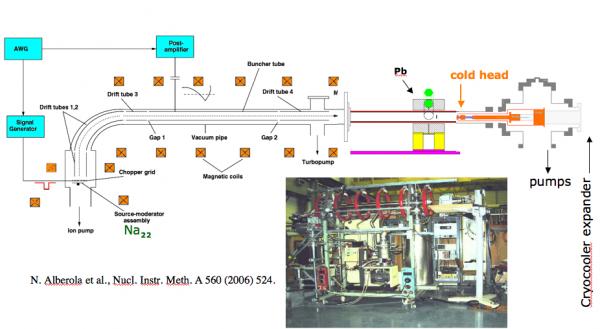In order to reach the final goal of the experiment, we must combine several elements coming each from a separate discipline in experimental physics. The production of positrons in large numbers will be obtained using an electron accelerator (see the SELMA and SOPHI projects). The storage of the produced positrons will be performed with a Penning-Malmberg trap as developed by C. Surko in San Diego or A. Mohri in Japan. They will then be extracted from this trap and dumped onto a material, with good properties to convert positrons into positronium, in a few tens of ns. The antiprotons coming from the AD at CERN are stored in a trap, such as the one developed by the ASACUSA collaboration, and extracted as a beam of a few KeV traversing the dense positronium cloud. The H+ ions thus formed are transported down to an atomic trap containing a low density of Be+ ions which slow them down to velocities of order 1 m/s. The H+ ions are then neutralised when their extra positron is photo-detached with a two-photon process in order to give no momentum along the vertical direction. The atoms then neutral fall on a scintillator where they annihilate, producing an energy large enough to provide their arrival time t2 on this scintillator. The distance dx between the horizontal laser beam and trigger time t1 of the laser beam being known, the value of the gravitational acceleration g on these antihydrogen atoms is given by the famous formula dx = 1/2 g (t2-t1)2.
The AD/ELENA beam will provide approximately 6 106 antiprotons of 100 KeV per bunch every 110 s. These antiprotons will be transported to and traverse a dense target of positronium atoms (around 1012 cm-2). While going through this target, the antihydrogen atoms and the H+ ions are formed. We estimate that 1 to 10 ions are formed per pulse of 107 antiprotons. Around 1000 neutral atoms are also formed in the fundamental state.
In order to create the positronium target, 1010 positrons are dumped onto a material which converts them into positronium within a few tens of nanoseconds. These time spans take into account the time it takes to dump the antiprotons as well as the lifetime of positronium of 142 ns (triplet state). The fast extraction from the trap has been checked with the MRT trap in the RIKEN laboratory.

Sketch of the slow positron beam line of ETH Zurich at CERN. The TOF and cryocooler are visible at the right end.
Materials able to convert positrons into positronium are prepared in Nancy, Mulhouse, Ecole Polytechnique or Saclay. Materials with the highest conversion efficiency are selected as checked firstly at CERI (Orléans) where the production rate of ortho-positronium (oPs), the triplet state with a long lifetime (142 ns), is measured. We also select those materials emitting in vacuum oPs atoms with the lowest possible velocity. This is achieved by placing samples in the slow positron beam of ETH Zurich at CERN. A time of flight measurement system has been added in order to determine the velocity of the emitted positronium atoms. A sample holder coupled to a cryocooler and a heater allows to study the performances of these materials as a function of temperature (10-600K). A lifetime measurement system completes this set in order to improve the estimate of the fraction of oPs produced.
Five BGO counters surround a lead cylinder cut in two halves by a variable width slit. The lead is placed around the vacuum beam pipe. Slow positrons (1-5 KeV) are implanted into the sample to be studied. The oPs which is emitted into vacuum flies back until it decays emitting 3 photons whose energy sum 1.022 MeV. When one of these photons passes through the slitto reach one of the counters, its energy, as well as its arrival time, are registered. The distance between the slit and the sample is known. The time when the positron hits the sample is given by secomndary electrons emitted during the interaction between the incident positron and the sample. These electrons are detected with an MCP (Multi Channel Plate). The set of counters and lead can be moved with respect to the sample along the beam axis.
Our specificity consists in using the H+ ion in the following two reactions.
